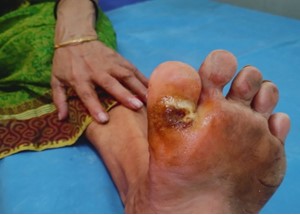A randomized controlled clinical study to evaluate the efficacy of Haridra Arka in the management of Dushta Vrana vis-à-vis Chronic Non-Healing Ulcer
DOI:
https://doi.org/10.21760/jaims.9.1.2Keywords:
Dushta Vrana, Haridra Arka, Betadine, Chronic Non-Healing Ulcer, AyurvedaAbstract
Introduction: A chronic wound is a wound that does not heal in an orderly set of stages and in a predictable amount of time. Any wound after 7 days is to be considered as Dushta Vrana. The use of Arka preparations in Vrana is mentioned in classics. Objective: To evaluate the efficacy of Haridra Arka in the management of Dushta Vrana and to study the anti-microbial property of Haridra Arka. Methodology: A single blind clinical study with pre-test and post-test design. The 30 patients with diagnostic criteria of Dushta Vrana were selected from Muniyal Institute of Ayurveda Medical Sciences, Manipal. In Group A, the wound is cleaned and dressed with Haridra Arka. In the control group, Betadine was used for dressing. Wound management done once in a day. Duration of the study for 30 days or till the formation of granulation tissue. Follow-up done once in 7 days for 1 month. The data were graded based on the assessment criteria and were analysed statistically. Results: The outcome of the treatment after 30 days showed high statistical significance in parameters like depth, edge and exudates amount, and other parameters like pain, itching, smell, undermining, necrotic tissue type, necrotic tissue amount, exudates type, skin colour surrounding the wound and granulation tissue showed statistical significance. Conclusion: Both these treatments showed reduction in symptoms but Group B in which Betadine was used showed better results. It can be concluded that Haridra in the form of Arka is not very effective in the management of Dushta Vrana when compared to Betadine.
Downloads
References
Acharya YT. Commentary Nibandha sangraha of Dalhanacharya on Sushrutha Samhitha, SutraSthana; Vedotpathi: Chapter No.-1: Verse- 7. Varanasi: Chaukambha Sanskrit Sansthan; 2017.
Agale SV. Chronic Leg Ulcers: Epidemiology, Aetiopathogenesis, and Management. Ulcers. 2013;2013:413604.
Acharya YT. Commentary Nibandha sangraha of Dalhanacharya on Sushrutha Samhitha, Chikitsa Sthana; Dvivraneeyachikitsitam: Chapter No.-1: Verse-8. Varanasi: Chaukhambha Sanskrit Sansthan; 2017.
Farhat F, et al. Curcumin in wound Healing-A Bibliometric Analysis. Life (Basel. Switzerland). 2023;13(1):143. doi:10.3390/life13010143.
Noure SD, Dosoky, N Setzer W. Chemical Composition and Biological activities of Essential oils of Curcuma Species. Published online September 1, 2018.
Acharya YT. Commentary Nibandha sangraha of Dalhanacharya on Sushrutha Samhitha, SutraSthana; Misrakadhyaya: Chapter No.-37: Verse-19. Varanasi: Chaukambha Sanskrit Sansthan; 2017.
Acharya YT. Commentary Nibandha sangraha of Dalhanacharya on Sushrutha Samhitha, Chikitsa Sthana; Vidradichikitsitam: Chapter No.-16: Verse-15. Varanasi: Chaukhambha Sanskrit Sansthan; 2017.
Tripathi I. Arkaprakasha of Langapati Ravan, Hindi teeka. (2nd ed.). Varanasi: Krishadas; 2006.
Panda P, et al. Arka Kalpana & Its Importance In Ayurveda. International Ayurvedic Medical Journal. 2019. Available from: http://www.iamj.in/posts/images/upload/413_418.pdf
Harris C, Bates-Jenson B, Parslow N, Raizman R, Singh M, Ketchen R. Bates-Jenson wound assessment tool: pictorial guide validation project. J Wound Ostomy Continence Nurs. 2010;37(3):253-259. doi:10.1097/WON.0b013e3181d73aa.















